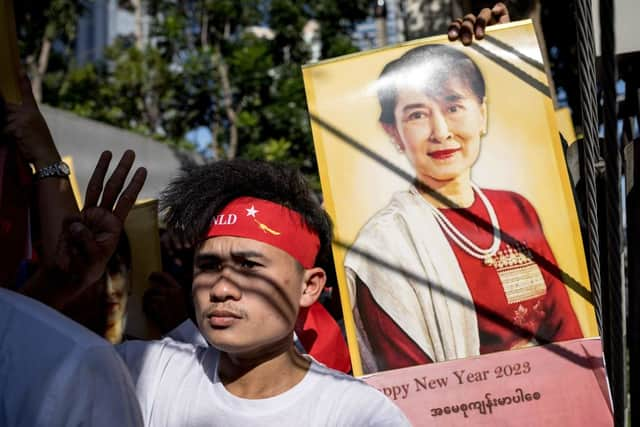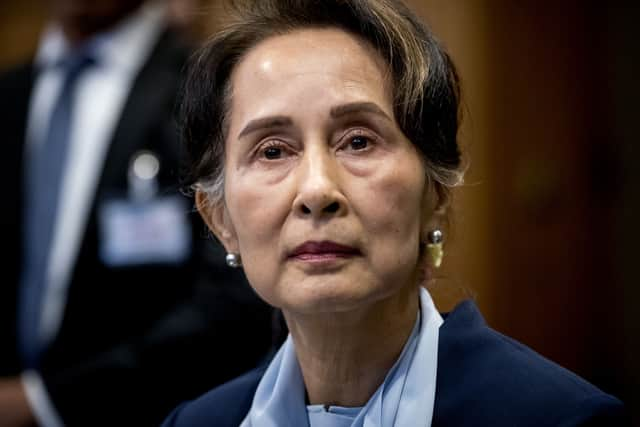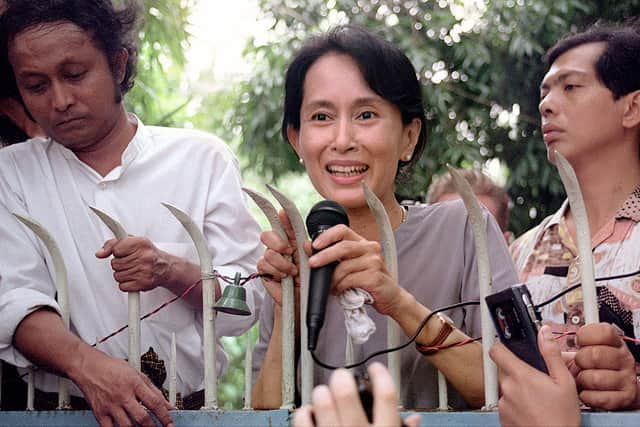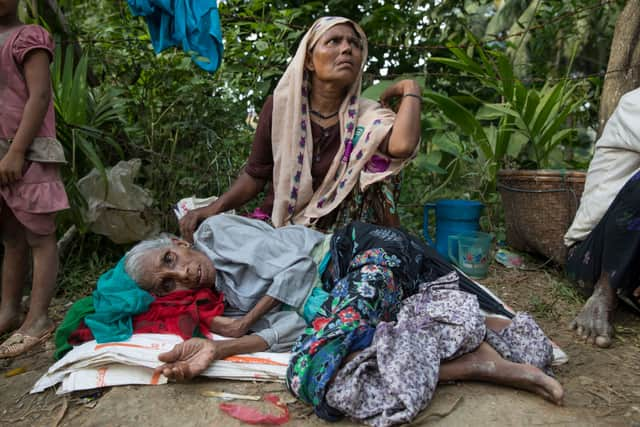Who is Aung San Suu Kyi? Myanmar court sentences ousted leader to seven years’ in prison for corruption
and live on Freeview channel 276
A court in military-ruled Myanmar has convicted the country’s ousted leader Aung San Suu Kyi of corruption, sentencing her to seven years in prison.
The court’s action leaves her with a total of 33 years to serve in prison, and is the latest in a series of politically-tinged prosecutions after the army toppled her elected government in February 2021.
Advertisement
Hide AdAdvertisement
Hide AdThe 77-year-old has also been convicted of several other offenses, including illegally importing and possessing walkie-talkies, violating coronavirus restrictions, breaching the country’s official secrets act, sedition and election fraud. All her previous convictions had landed her with a total of 26 years’ imprisonment.
Phil Robertson, deputy Asia director of Human Rights Watch, said: “From start to finish, the junta grabbed whatever it could to manufacture cases against her with full confidence that the country’s kangaroo courts would come back with whatever punitive judgments the military wanted. Due process and a free and fair trial were never remotely possible under the circumstances of this political persecution against her.”
In the five counts of corruption decided on Friday, Suu Kyi was alleged to have abused her position and caused a loss of state funds by neglecting to follow financial regulations in granting permission to Win Myat Aye, a Cabinet member in her former government, to hire, buy and maintain a helicopter. Suu Kyi was the de facto head of government, holding the title of state counsellor. Win Myint, who was president in her government, was a co-defendant in the same case. The defendants denied all the charges, and her lawyers are expected to appeal in the coming days.


Her supporters and independent analysts say the charges against her are an attempt to legitimise the military’s seizure of power while eliminating her from politics before an election it has promised for next year. Friday’s verdict in the purpose-built courtroom in the main prison on the outskirts of the capital, Naypyitaw, was made known by a legal official who insisted on anonymity for fear of being punished by the authorities.
Advertisement
Hide AdAdvertisement
Hide AdThe trial was closed to the media, diplomats and spectators, and Suu Kyi’s lawyers were barred by a gag order from talking about it. The end of the court cases against Suu Kyi, at least for now, raises the possibility that she would be allowed outside visitors, which she has been denied since she was detained.
Allowing access to Suu Kyi has been a major demand of the many international critics of Myanmar’s military rulers, who have faced diplomatic and political sanctions for their human rights abuses and suppression of democracy.


Who is Aung San Suu Kyi?
Suu Kyi, the daughter of Myanmar’s martyred independence hero General Aung San, spent almost 15 years as a political prisoner under house arrest between 1989 and 2010. Her tough stand against the military rule in Myanmar turned her into a symbol of nonviolent struggle for democracy, and won her the 1991 Nobel Peace Prize.
Her National League for Democracy party initially came to power after easily winning the 2015 general election, ushering in a true civilian government for the first time since a 1962 military coup.
Advertisement
Hide AdAdvertisement
Hide Ad

Her party won a landslide victory again in the 2020 election, but less than three months afterwards, elected officials were kept from taking their seats in Parliament and top members of her government and party were detained. The army said it acted because there had been massive voting fraud in the 2020 election, but independent election observers did not find any major irregularities.
The army’s takeover in 2021 triggered widespread peaceful protests that security forces tried to crush with deadly forces and that soon erupted into armed resistance.
Suu Kyi married English historian Michael Aris in 1972 after meeting at Oxford University. Aris was an expert in Bhutanese, Tibetan and Himalayan culture, who died from prostate cancer in 1999.
The couple last met in 1995 after Aris was refused entry to Myanmar. She was was granted a temporary freeze to her house arrest to visit her husband outside the country at this time, she refused to leave the country over fears she would not be allowed to re-enter the country. The couple gave birth to two children; Alexander Aris, born in 1973, and Kim Aris, born in 1977.
Advertisement
Hide AdAdvertisement
Hide Ad

What happened to the Rohingya?
After coming to power, Suu Kyi was criticised for showing deference to the military while ignoring atrocities it is credibly accused of committing in a 2017 crackdown on the Rohingya Muslims. The minority group has been persecuted on a regular basis by the Buddhist majority since the 1970s.
In 2016 and 2017, Myanmar armed forces launched new crackdowns on the Rohingya, which UN officials have said could amount to genocide. In 2018, a UN report found that the military was “killing indiscriminately, gang-raping women, assaulting children and burning entire villages” in Rakhine, in the north-west of Myanmar.
The UN Security Council estimated at least 25,000 people have been killed, and more than 700,000 Rohingya fled over the border to Bangladesh, creating the world’s biggest refugee camp. Suu Kyi and the military denied the claims, saying that the armed forces were appropriately responding to terrorists.
The UN criticised Suu Kyi at the time, saying: “[She] has not used her de facto position as head of government, nor her moral authority, to stem or prevent the unfolding events in Rakhine state.”
Comment Guidelines
National World encourages reader discussion on our stories. User feedback, insights and back-and-forth exchanges add a rich layer of context to reporting. Please review our Community Guidelines before commenting.
